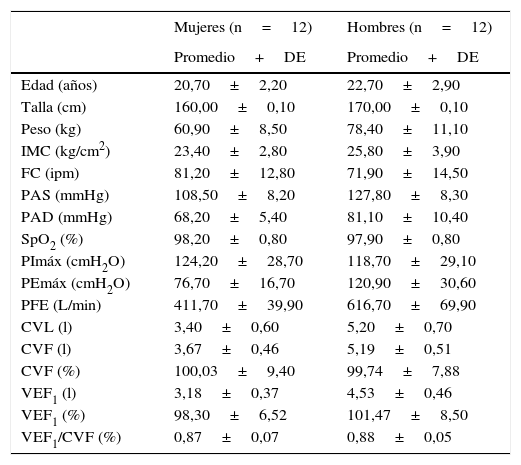Analizar los efectos hemodinámicos y ventilatorios de la aplicación del Cough Assist® y compararlos con los efectos promovidos por la tos voluntaria.
Material y métodosEnsayo clínico aleatorizado. La muestra se compuso de 24 sujetos jóvenes sanos, sometidos a 3 protocolos distintos, utilizando Cough Assist® con presiones respiratorias comunes a la práctica clínica: 30S – presión I/E de +30/–30 cmH2O; 50S – presión I/E de +50/–50 cmH2O, y tos voluntaria (TV). Los protocolos se aplicaron a todos los sujetos, con un intervalo entre ellos de al menos 24 h. Se valoraron los parámetros de frecuencia cardiaca, presión arterial, saturación periférica de oxígeno capacidad vital lenta y pico de flujo espiratorio previo a la aplicación de los protocolos (PRE), inmediatamente posterior (POST) y en 20 min (20′ POST). Los análisis estadísticos se realizaron mediante ANOVA de io ii vías y Bonferroni post hoc. Se consideró un nivel de significación estadística de p < 0,05.
ResultadosLos efectos promovidos por el Cough Assist® fueron similares a los promovidos por la tos voluntaria. En las mujeres no hubo repercusiones significativas en los parámetros valorados. En los hombres la aplicación del Cough Assist® y la TV condujeron un aumento de la frecuencia cardiaca, y únicamente la utilización del equipo aumentó la saturación periférica de oxígeno.
ConclusiónEl uso del Cough Assist® con presiones medias y altas no conlleva a repercusiones cardiopulmonares relevantes y su uso se puede considerar similar a los efectos fisiológicos promovidos por la tos voluntaria.
To analyse the haemodynamic and ventilatory effects of the application of Cough Assist® and compare them to those caused by the realization of voluntary cough.
Material and methodsA randomised clinical trial. The sample consisted of 24 young healthy subjects who underwent three different protocols using Cough Assist® with common respiratory pressures into clinical practice: 30S – pressure I/E +30/–30 cmH2O; 50S – pressure I/E +50/– 50 cmH2O; and voluntary cough. Protocols apply to all subjects, with a time interval between them of at least 24hours. The parameters evaluated were heart rate, blood pressure, peripheral oxygen saturation, slow vital capacity and peak expiratory flow prior to application protocols (PRE), immediately after (POST) and 20minutes after (20’ POST). Statistical analysis was performed by ANOVA of i or ii pathways and post hoc of Bonferroni. For all analysis were considered a level of statistical significance of P<.05.
ResultsThe effects caused by the Cough Assist® were similar to those of voluntary coughing. In women, none of them cause significant impact on the evaluated parameters; in men, both machine and voluntary cough led to increased heart rate, and the application of the Cough Assist® increased peripheral oxygen saturation. The other variables remained unchanged.
ConclusionThe application of the Cough Assist® in medium and high pressure does not cause relevant cardiorespiratory repercussions, being similar to the physiological effects caused by the voluntary cough.
Artículo
Si ya tiene sus datos de acceso, clique aquí.
Si olvidó su clave de acceso puede recuperarla clicando aquí y seleccionando la opción "He olvidado mi contraseña".Comprando el artículo el PDF del mismo podrá ser descargado
Precio 19,34 €
Comprar ahora














